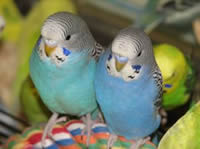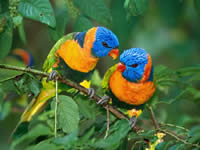Difference between Parakeets and Lorikeets
Key Difference: Parakeets are small to medium sized and have a long tail feathers. They can range in size from about 7” up to 18”. Lorikeets are small to medium-sized arboreal parrots, which fall into a different sub-species due to their specialized brush-tipped tongues. They can range from 6” to 16” in size and are also have a bright plumage.
Parakeets and Lorikeets are related to each other but belong to different subfamilies. Both the birds are also related to Parrots, who also belongs to the same family. It can be assumed that Parakeets and Lorikeets are cousins, with different features and habits.

Parakeets are small to medium sized and have a long tail feathers. They can range in size from about 7” up to 18”. Parakeet families include various subspecies depending on different factors such as region, habitat, diet and appearance. The Budgerigar Parakeet, also known as "Budgie" or English Parakeet is the most common type of parakeet that is sold and bred world-wide. Male and female parakeets can be distinguished by the cere, a small strip color on their beaks; if the cere is brown or pinkish, it is a female, while bright blue suggests the bird is a male.
A parakeet has a long slender body, long tail feather, is available in bright colors and has a hooked bill. A small parrot can also be called a parakeet. Parakeets are native to Australia, Asia, tropical and sub-tropic regions of Africa, Central and South America, but they are now being breed all over the world. A parakeet’s diet consists primarily of seed and fruits.
 Lorikeets are small to medium-sized arboreal parrots, which fall into a different sub-species due to their specialized brush-tipped tongues. They can range from 6” to 16” in size and are also have a bright plumage. Lorikeet families have approximately 50 sub-species, of which some sub-species are endangered, such as the Ultramarine lorikeet and the Blue lorikeet. The sex of lorikeets is difficult to distinguish in many sub-species.
Lorikeets are small to medium-sized arboreal parrots, which fall into a different sub-species due to their specialized brush-tipped tongues. They can range from 6” to 16” in size and are also have a bright plumage. Lorikeet families have approximately 50 sub-species, of which some sub-species are endangered, such as the Ultramarine lorikeet and the Blue lorikeet. The sex of lorikeets is difficult to distinguish in many sub-species.
The specialized brush-tipped tongues are an important part of their diet that allows the birds to take nectar and pollen from flowers. The diet of parakeets includes pollen, nectar, fruits and vegetables. Lorikeets also have a hooked bill which is helpful for them to climb and hold things. Lorikeets are native to South-eastern Asia, Polynesia, Papua New Guinea, Timor Leste and Australia and can be most commonly found in rainforests, coastal bushes and woodland areas.
The main distinguishing feature between parakeets and lorikeets is the brush-tipped tongue of lorikeets and the massive difference in their diets. Lorikeets cannot survive on a seed based diet, while parakeets cannot survive on a nectar and pollen diet. Both the species are closely related to parrots and are intelligent and playful birds. Both the birds require ample amount of room to play in and attention. They can be taught to talk and make certain noises if trained properly. Lorikeets compared to parakeets are more expensive and require more attention. For more detailed differences, refer to the table below:
|
|
Parakeets |
Lorikeets |
|
Kingdom |
Animalia |
Animalia |
|
Phylum |
Chordata |
Chordata |
|
Class |
Aves |
Aves |
|
Order |
Psittaciformes |
Psittaciformes |
|
Family |
Psittaculidae |
Psittaculidae |
|
Subfamily |
Parakeets have many sub-families. |
Loriinae |
|
Appearance |
Parakeets are small to medium sized species of parrot that have long tail feathers. The Budgerigar Parakeet, also known as ‘Budgie’ is the most common parakeet. Parakeets vary in size from about 7" up to 18" in length and are very colorful birds. Parakeets, similar to parrots also have a hooked-bill used for climbing, holding things or chewing. |
Lories or Lorikeets are small to medium-sized arboreal parrots, which fall into a different sub-species due to their specialized brush-tipped tongues and their diet of nectar and fruits. They range from 6" to 16" and their colors vary depending on their species, however they most commonly are found in bright colors. The sex of the birds is difficult to distinguish in most species. |
|
Distinguishing feature |
Parakeets have a slender body, and long, tapered tail feathers. They also have a hooked bill. |
The specialized brush-tipped tongue to feed on nectar and pollen from flowers. Species with longer tails are called lorikeets, while short blunt tales are known as lories. |
|
Diet |
Parakeets have a strict mix-seed diet. The mix should include sprouted seed, various fruits, green foods, commercial pellets, millet spray. They also require a helping of fresh, dark greens and small slices of fruit daily. |
Lorikeets have a specialized diet, which primarily depends on nectar and pollen. Wet nectar and dry pollen are now available in pet stories, making it easier to feed these birds. A daily supply of vegetables and fruits are also important to maintain the bird’s health. |
|
Life expectancy |
Parakeets have a life expectancy of 5-7 years. |
Lorikeets are usually lively and healthy creatures and can have a life expectancy of 7-9 years. |
|
Housing requirements |
Parakeets require large cages which allow maximum room for movement. If a parakeet is a medium size cage, it will have to be let out for exercise. The cage will also require bird perch for it to sit on. Parakeets are happier in pairs or a community. |
Single birds can be kept in a small cage, but they require room to move and fly. Most lorikeet species are more happy in pairs or communities, while some (the Red, the Blackcapped and the Yellow-bibbed) prefer solitude. The base of the cage should be aluminum or some type of metal for easy cleaning. |
|
Demeanor |
Parakeets are very social creatures and get along very well with humans and other pets. Parakeets are flock oriented birds and require a full-time companion or maximum companionship. |
Lorikeets are outgoing in nature and some species can be more aggressive compared to others. Lorikeets are very active and require constant companionship and stimulation. Lorikeets are noisy and have a loud chatter, but are intelligent creatures and can be trained to talk. |
|
Native to |
Australia, Asia, tropical and sub-tropic regions of Africa, Central and South America. |
South-eastern Asia, Polynesia, Papua New Guinea, Timor Leste and Australia. |
|
Habitat |
Timbered grasslands, dry scrublands and open plains; timbered areas bordering watercourses. |
Rainforests, coastal bushes and woodland areas. |
|
Nesting/mating |
Parakeet breeding is fairly easy. Parakeets are monogamous birds, meaning they mate for life. Pairs of breeding parakeets should be separate from the community as they can sometimes become aggressive while mating. Parakeets require a nesting box in order to lay in it. |
Lories become very aggressive during mating/nesting. They are encouraged to mate by other members of the community, but when they pick a pair, its best to separate the pair from the rest. |
|
Hygiene |
Parakeets require clean and hygienic cages in order to live and will become pretty quickly if dirty places. The cages, food dishes and toys should be thoroughly and cleaned and disinfected (yearly). |
The house conditions of a lorikeet should be kept clean and any uneaten food should be removed immediately in order to keep them healthy and happy. |
|
Cost |
US$10-100, depending on the species and rarity. |
$50-$6500, depending on the species and how rare they are. |
Image Courtesy: cool-small-pets.com, myopera.com









Add new comment